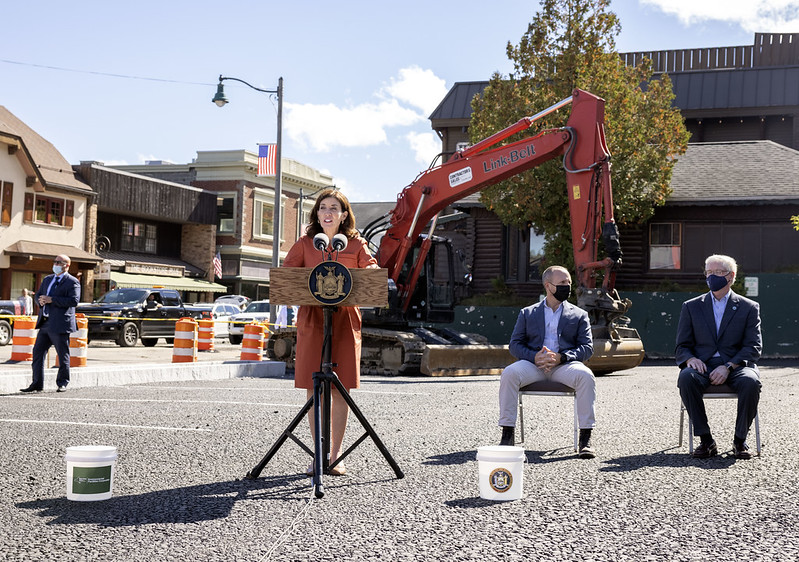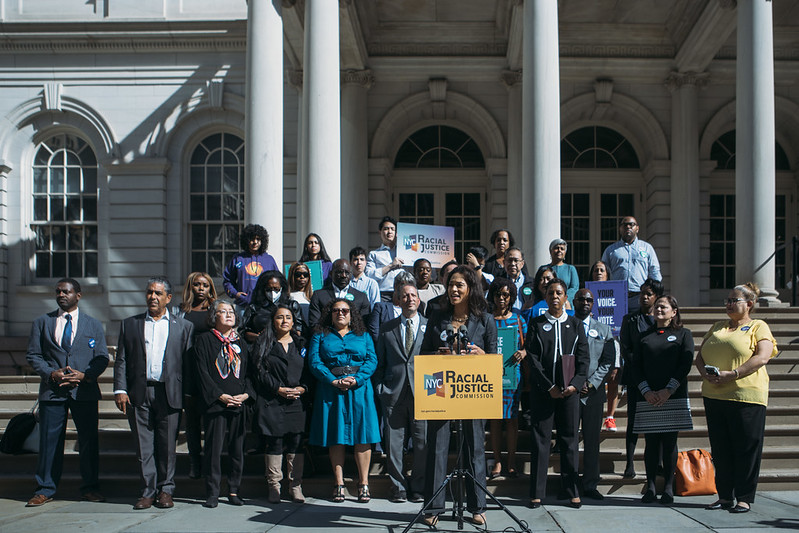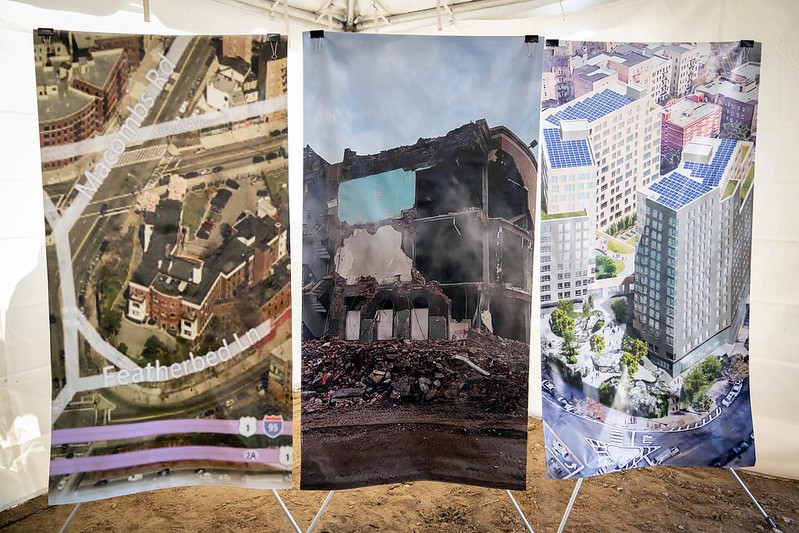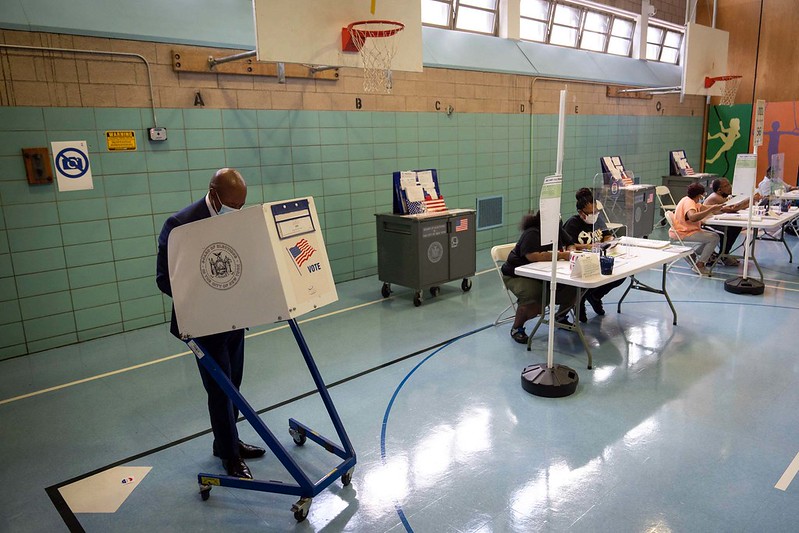The Role New York's Nonprofits Play in Construction Safety

Construction safety rally at City Hall (photo: @Local79NYC)
If it seems like there has been more attention on construction safety in the city recently, it’s for good reason. According to the New York Committee for Occupational Safety & Health, between 2011 and 2015 the number of construction incidents that resulted in injury or death more than tripled. In the last four months, five workers have been killed on job sites, including one last weekend. It goes without saying that each of these preventable deaths is a tragedy that should push us into action.
A solution many have proposed is better job training for our city’s construction workforce. The City Council is currently debating construction safety legislation that would require anyone working on a large job site to first complete an apprenticeship program. The specifics of whether this legislation will pass and how it would be implemented in New York are unclear, particularly since the de Blasio administration does not support it.
But one thing that is clear – and has largely been ignored – is the important role that nonprofits have always played in training our city’s workforce, with a heavy focus on New York’s lowest income neighborhoods.
Along these lines, NYCHA leaders are right to speak out for expanding training opportunities for tenants looking to start careers in construction. Speaking from my own personal experience leading a workforce training program that has graduated nearly 100 low-income New Yorkers from all across the city, I can say that when it comes to job training, a modest investment can go a long way.
We spend seven weeks teaching students the basic skills necessary to start careers in construction – everything from the very basics of working on a job site to handling electric wiring and operating power tools. The majority of our trainees, who mostly come from NYCHA and other subsidized housing, are able to secure employment shortly upon graduating, in part because of our direct entry agreement with some of the city’s biggest trade unions.
What’s more, the trainees hone their skills on the types of projects that are often neglected, such as long-overdue Sandy recovery efforts in Staten Island and accessibility modifications on homes in Brooklyn and Queens occupied by low-income seniors who can’t afford to install ramps and lifts on their own. It’s a win-win for communities all across the city.
We are far from the only nonprofit with a holistic approach to job training and an emphasis on uplifting low-income communities. Other nonprofits, like Green City Force, Nontraditional Employment for Women (NEW), and Pathways 2 Apprenticeship, have developed programs specifically tailored for low-income New Yorkers seeking jobs. In fact, nonprofits have always played a leading role in creating a more diverse workforce, supporting communities often overlooked when it comes to hiring.
So while City Council debates legislation to curb construction accidents, I urge them to consider supporting and partnering with nonprofits that are already pursuing this work nimbly and effectively.
***
Kimberly George is Executive Director of Rebuilding Together NYC.
***
Have an op-ed idea or submission for Gotham Gazette? Email This email address is being protected from spambots. You need JavaScript enabled to view it.
The Best Way to Ensure New York Election Integrity? Modernize!

Governor Andrew Cuomo votes (photo: The Governor's Office on Flickr)
The Trump administration has made a series of unsupported claims about voter fraud that strike at the heart and integrity of our democracy. Beyond potentially undermining voters’ faith in our electoral system, these claims distract from a very real issue: New York’s voter registration system is badly in need of modernization.
Last month, President Trump repeated his unsubstantiated claim (originally tweeted in November) that as many as 5 million votes were illegally cast in the 2016 election and that an investigation would be forthcoming. Later, the White House press secretary suggested the investigation could focus on states where the Trump campaign did not invest significant resources, like California and New York (which Hillary Clinton won by a margin of 1.74 million votes). Then on Feb. 5, the administration announced that Vice President Mike Pence would head an investigative commission into 2016 voter fraud.
Let’s look at the basic evidence about these explosive claims.
First, election administrators from around the country say there is no evidence to support White House claims about the 2016 elections. Here in New York City, the executive director of the Board of Elections recently told the City Council that he was not aware of any voter fraud in the city.
The reality is that in-person voter fraud is virtually nonexistent. Numerous studies of the issue have shown only a handful of instances where fraudulent ballots were cast. One such study of more than 1 billion votes cast found exactly 31 incidents of voter fraud, a rate of less than 0.00001 percent.
Under former President George W. Bush, the attorney general instructed the Department of Justice to investigate voter fraud. After five years, U.S. Attorneys did not uncover any organized voter fraud effort and brought only about 100 successful prosecutions, many stemming from individuals who “mistakenly filled out registration forms or misunderstood eligibility rules.” Even states that have attempted noncitizen voter purges or aggressively pursued criminal investigations have been unsuccessful at uncovering anything more than isolated instances of unlawful voting. (It is worth noting that Senate Majority Leader Mitch McConnell has indicated he will not support funding an investigative commission because he has not seen sufficient evidence that fraud occurred.)
Despite this absence of evidence, lawmakers in some states have used voter fraud claims as a pretext to restrict voting access.
Another key element of the administration’s claims is the phenomenon of “double registration,” which occurs when a voter is registered in two (or more) states. Though it is illegal to cast multiple ballots, being registered to vote in two states is not illegal. In fact, double registration is fairly common: a 2008 Pew study found that one in eight voter registrations are inaccurate or invalid. This is because people often move or buy property in different states, such as when college students register in the state where their school is located.
The 1993 National Voter Registration Act requires states to maintain current and accurate lists and includes important safeguards to protect voters from erroneous removal. To maintain up-to-date lists, election administrators compare the voter rolls to other government data maintained by the Social Security Administration and the Post Office. More recently, states have begun comparing their rolls against lists in other states through exchanges like the Electronic Registration Information Center (ERIC), a practice endorsed by the Presidential Commission on Election Administration.
Some states are making strides to update their technology to get more eligible citizens onto the voter rolls and to keep the rolls accurate, but New York’s system is woefully out-of-date. Our paper-based system leads to typos, names missing from the poll books, and other errors which prevent eligible voters from casting a ballot that counts. Even worse, hundreds of thousands of voters have been illegally purged from the rolls, stripping those New Yorkers of their voting rights.
This is a moment for New York to take leadership on voting rights and use technology to increase access to the ballot. Common-sense reforms like the Voter Empowerment Act, or the New York Votes Act that was introduced by Attorney General Eric Schneiderman last week, would ensure that every voter can easily register and participate in our elections. Modernizing our voter registration system is the best way to ensure the integrity of our elections – not another search for voter fraud that experts and experience tell us does not exist.
***
Amy Loprest is executive director of the New York City Campaign Finance Board and the city’s NYC Votes voter engagement campaign.
***
Have an op-ed idea or submission for Gotham Gazette? Email This email address is being protected from spambots. You need JavaScript enabled to view it.
Beware of 'Common Sense' Arguments Against the Millionaire's Tax

Assembly Speaker Carl Heastie (photo: The Governor's Office)
Higher taxes on New York’s wealthy are on the table in three places for this year’s budget negotiations. Governor Andrew Cuomo’s Executive Budget for 2018 includes an extension of the so-called "millionaire’s tax”. The state Assembly has decided to see the governor and raise him with their proposed “gazillionaire’s tax”, while Mayor de Blasio has proposed a “mansion tax”.
The Democratic-controlled Assembly favors them all. The Republicans, who control the state Senate, are against all three. But the governor exerts a great deal of control over the New York State budget process and holds most of the cards. And while the governor is the one proposing the extension of the millionaire’s tax, he doesn’t appear to support the others. So is there any reason for progressives to believe that the mansion tax, let alone the gazillionaire’s tax, might pass now?
For starters, taxes on the wealthy are broadly popular with voters. Just like raising the minimum wage, even Republican voters tend to favor these types of taxes, as do the wealthy themselves irrespective of party affiliation. A recent Siena Poll showed New Yorkers in favor of extending the millionaire’s tax by a margin of 74 percent to 23 percent, with 61 percent of Republicans on board along with 81 percent of Democrats.
On the other hand, Republicans are offering arguments that have worked before. They say that New York is already over-taxed, and that taxes on the high earners will just drive them to leave the state and take their job-creating business with them. Corporate-backed “non-partisan” groups take the same position, as Governor Cuomo often does as well.
If Republicans can be said to believe in just one thing, it is that progressive tax policies will drive the rich away and impoverish all who remain, bereft of “job creators”. From Ayn Rand and Galt’s Gulch, to Ronald Reagan and the Laffer Curve, to ALEC and Stephen Moore today, the argument that higher taxes will make the rich work less or move to some promised land of lower taxes is one of the most consistent pieces of Republican philosophy. But are any of their arguments actually grounded in observable reality?
Republicans rarely cite any empirical research to back their claims. Why should they when it’s just “common sense”? But does reality back up the “common sense” of the GOP? The answer is definitively “no”.
Study after study after study has shown no significant pattern of wealthy people moving from high-tax to low-tax states, and no noticeable change in the net migration rates of high earners between US states in the wake of changes in their relative tax rates. And there is no evidence that either hours worked or income earned by high earners overall is reduced meaningfully by higher tax rates.
Republicans can always find anecdotal evidence that high taxes will drive or are driving the rich from high to low-tax states. But one rich person who moves from Manhattan to Miami proves nothing. All kinds of people, rich and poor, move from New York to Florida every year. And all kinds of people move from Florida to New York. The net effect is tiny, and made up for by people moving to New York from other states and other countries.
New York’s millionaire’s tax first passed in 2009. As you can see here, here, here and here, the primary argument used against it was that rich people were going to move. And when the millionaire’s tax was renewed in 2011, the same arguments were made, including by Governor Cuomo himself.
With the better part of a decade’s worth of data, were the “common sense” mongers of the Right actually correct? No, no and no. New York’s rich haven’t flown off to lower tax states. Property values at the upper end of the New York real estate market have risen unabated. All their warnings have come to naught.
So Assembly Speaker Carl Heastie and Assemblymember Herman Farrell, armed with observable fact and measurable experience, have introduced the gazillionaire’s tax. It extends the logic of the millionaire’s tax with a series of four additional tax brackets starting at $5,000,000 and adding at most 1.5 percentage points of incremental tax on incomes over $100,000,000 per year. That’s not a typo, and yes there are multiple households in New York with annual incomes above $100,000,000, and former Mayor Michael Bloomberg’s isn’t the only one.
The objections to the gazillionaire’s tax are no different than the objections to the millionaire’s tax, and they are just as certain to be completely wrong in the real world. Republican arguments against higher taxes are premised in deeply faulty views of both human nature and economics. The richest of the rich don’t wake up every morning and say, “Hmmm, I will work today if my tax rate is 47 percent, but I will go back to sleep or move to Florida if it’s 48.5 percent.” We are talking about people who could never spend all of the money they have already earned. They keep working as hard as they do for a variety of reasons, like relative success, prestige, and actual enjoyment in their work, with take-home pay being just one item on a long list.
Arguments against the mansion tax are essentially the same but even weaker. They don’t even have “common sense” to fall back on. Where’s the common sense in stating that a 2.5 percent tax surcharge on proceeds in excess of $2 million will have any effect on home sales? Are people not going to move when it’s time to move because of it? Of course not. It’s just a wealth tax applied on a transactional basis.
Massive, long-term, structural trends -- trends that many Trump voters are incidentally rebelling against -- have been and will continue to drive the relative success of America’s, and the world’s, largest and strongest cities. Clusters of like-minded people, of competitive college graduates from all over the country and the world, will continue to grow and prosper. “Trends” that major industries, like financial services, are going to move to low-tax states are perennially flogged by the Right. But they never actually happen.
So the next time you hear someone say, “You can’t raise taxes on the rich in New York, they already pay too much and they’ll just move to Texas or Florida; it’s just common sense”, you should say, “Yes we can raise taxes on the richest New Yorkers, all of the data over many years and many studies has shown definitively that they aren’t going anywhere, so you can stick your common sense in a hot, humid, boring low-tax state with low-wage jobs.” Now that’s just common sense.
***
Gus Christensen is a financial consultant to non-profits and start-ups, as well as a former investment banker and political candidate.
***
Have an op-ed idea or submission for Gotham Gazette? Email This email address is being protected from spambots. You need JavaScript enabled to view it.




